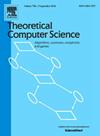Parameterized algorithms for multi-label periodic temporal graph realization
IF 1
4区 计算机科学
Q3 COMPUTER SCIENCE, THEORY & METHODS
引用次数: 0
Abstract
In the periodic temporal graph realization problem introduced by Klobas et al. [SAND '24] one is given a period Δ and an matrix D of desired fastest travel times, and the task is to decide if there is a simple periodic temporal graph with period Δ such that the fastest travel time between any pair of vertices matches the one specified by D. We generalize the problem from simple temporal graphs to temporal graphs where each edge can appear up to ℓ times in each period, for some given integer ℓ. For the resulting problem Multi-Label Periodic TGR, we show that it is fixed-parameter tractable for parameter n and for parameter , where vc is the vertex cover number of the underlying graph. We also show the existence of a polynomial kernel for parameter , where nu is the number of non-universal vertices of the underlying graph and is the largest entry of D. Furthermore, we show that the problem is NP-hard for each , even if the underlying graph is a tree, a case that was known to be solvable in polynomial time if the task is to construct a simple periodic temporal graph, that is, if .
多标签周期时间图实现的参数化算法
周期时序图的实现问题引入Klobas et al .(砂24]给出一段时间Δ和一个n×n矩阵D所需的最快的旅行时间,任务是决定如果有一个简单的周期时序图与Δ这样最快的旅行时间任何一对顶点之间匹配指定的一个D我们推广这个问题从简单的时序图,时序图,每条边可以ℓ倍出现在每一个时期,对于某个给定的整数。对于由此产生的多标签周期TGR问题,我们证明了它对于参数n和参数vc+Δ是固定参数可处理的,其中vc是底层图的顶点覆盖数。我们还证明了参数nu+dmax的多项式核的存在性,其中nu是底层图的非泛顶点的个数,dmax是d的最大入口。此外,我们证明了对于每个r≥5的问题是np困难的,即使底层图是树,如果任务是构造一个简单的周期时间图,即,如果r =1,这种情况已知在多项式时间内可解。
本文章由计算机程序翻译,如有差异,请以英文原文为准。
求助全文
约1分钟内获得全文
求助全文
来源期刊

Theoretical Computer Science
工程技术-计算机:理论方法
CiteScore
2.60
自引率
18.20%
发文量
471
审稿时长
12.6 months
期刊介绍:
Theoretical Computer Science is mathematical and abstract in spirit, but it derives its motivation from practical and everyday computation. Its aim is to understand the nature of computation and, as a consequence of this understanding, provide more efficient methodologies. All papers introducing or studying mathematical, logic and formal concepts and methods are welcome, provided that their motivation is clearly drawn from the field of computing.
 求助内容:
求助内容: 应助结果提醒方式:
应助结果提醒方式:


